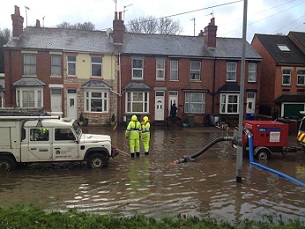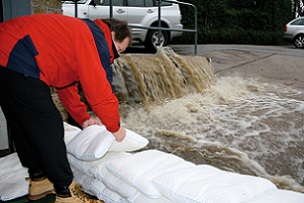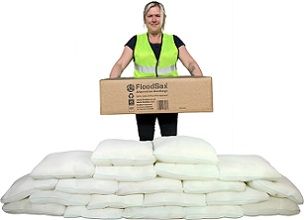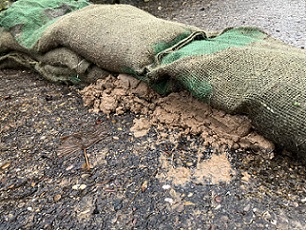 Floodwater wrecks homes, businesses and lives
Floodwater wrecks homes, businesses and lives
 FloodSax alternative sandbags can hold back a torrent of floodwater
FloodSax alternative sandbags can hold back a torrent of floodwater
 All these 20 FloodSax sandless sandbags came from this one easy-to-carry box
All these 20 FloodSax sandless sandbags came from this one easy-to-carry box
 Sandbags quickly deteriorate and spill sand everywhere
Sandbags quickly deteriorate and spill sand everywhere
The harsh truth we’ve learned about sandbags from ITV drama After The Flood
The recent gripping ITV drama After The Flood has shown the devastating power of water … and in one scene angry flood victims berate the council for not providing sandbags.
The stark truth is that local authorities have absolutely no responsibility to provide sandbags or any other anti-flood devices for homes and businesses … and some even admit that sandbags don’t work well at keeping water out anyway.
A few councils still hand out sandbags as a gesture of goodwill, especially if they are in an area particularly vulnerable to flooding, but the vast majority don’t and with council budgets cut to the bone that’s highly unlikely to change. In fact, councils that provide sandbags are now probably less likely to do so in the future.
The Environment Agency states: “Don’t assume the authorities will provide you with sandbags in a flooding emergency. It’s the responsibility of property owners to take appropriate action to protect their property from flooding. Sandbags are relatively ineffective when compared to purpose-built flood protection products. We strongly encourage people to use these products.”
Bradford Metropolitan District Council makes the position absolutely clear, stating: “There is no statutory requirement for a Local Authority to provide sandbags, nor to prevent a property from flooding. Many councils do not provide sandbags.”
Several councils are now actively urging people to get FloodSax alternative sandbags for flood mitigation provided by Environmental Defence Systems Ltd, based in Yorkshire which is an area well used to flooding. FloodSax are far easier to store and deploy than traditional sandbags which are heavy, cumbersome, difficult to use and can be ineffective.
FloodSax are far more flexible and multi-purpose than sandbags as they come vacuum-packed in space-saving bags so hundreds can be transported in a car, yet immerse a FloodSax in water then its gelling polymer absorbs the water and retains it, transforming it into an instant sandbag but without the sand.
In their dry state the gelling polymer inside FloodSax can quickly soak up water dripping or leaking inside buildings to stop damage from spreading and they are used extensively like this in homes, businesses and public buildings including supermarkets and hospitals. They are very thin with a large surface area so can be slipped underneath leaking radiators, boilers, sinks and water pipes.
Adur and Worthing Councils in West Sussex say: “The Environment Agency now says that anti-flood devices like FloodSax are the way forward for people to protect their home.”
Braintree District Council in Essex adds: “The council does not have a statutory duty to provide residents with sandbags during a flooding incident. It is the homeowner’s or landlord’s responsibility to protect their property. Flood defence products, e.g. FloodSax or similar products can be purchased at builders’ merchants or DIY stores.”
Lucy Bailey from Environmental Defence Systems Ltd said: “TV series such as After The Flood bring home to people the harsh reality of flooding, how water wrecks everything it touches and forces people out of their homes for months and even years while expensive repairs costing tens of thousands of pounds are carried out.
“There is also a scene in After The Flood where people are having a go at a councillor for not providing sandbags. The short answer is they don’t have to and, even in the few areas where councils do provide sandbags, it’s very difficult to get them to the scene in time when flooding is imminent as they are so heavy and cumbersome to transport and deploy anywhere.”
The average cost of flood damage to a house is £31,000 and for businesses it’s usually more than £70,000 with many not opening again once they’ve been flooded. People usually have a to pay a huge excess on their insurance too.
Around 3 million FloodSax have now been sold worldwide for flood resilience, flood protection and flood control both indoors and outside.
For more information on FloodSax go to www.floodsax.co.uk